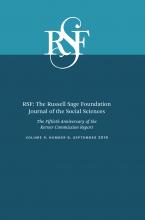Research Article
Open Access
The Evolution of Black Neighborhoods Since Kerner
Marcus D. Casey, Bradley L. Hardy
RSF: The Russell Sage Foundation Journal of the Social Sciences September 2018, 4 (6) 185-205; DOI: https://doi.org/10.7758/RSF.2018.4.6.09
Marcus D. Casey
aDavid M. Rubenstein Fellow in Economic Studies at the Brookings Institution and assistant professor in the Department of Economics at the University of Illinois at Chicago
Bradley L. Hardy
bAssociate professor in the Department of Public Administration and Policy at American University

REFERENCES
- ↵
- Andrews, Rodney,
- Marcus Casey,
- Bradley Hardy, and
- Trevon Logan
- ↵
- ↵
- Autor, David
- ↵Bartik, Timothy J. 2018. “Economic Development Incentives: Who Benefits? Who Pays the Costs? How Can They Be Improved?” W. E. Upjohn Institute Technical Report no. 18-034. Kalamazoo, Mich.: W. E. Upjohn Institute for Employment Research. Accessed May 9, 2018. http://research.upjohn.org/cgi/viewcontent.cgi?article=1037&context=up_technicalreports.
- ↵Baude, Patrick, Marcus Casey, Eric Hanushek, Gregory Phelan, and Steven Rivkin. 2018. “The Evolution of Charter School Quality.” NBER working paper no. 20645. Cambridge, Mass. National Bureau of Economic Research.
- ↵
- ↵Blank, Rebecca. 2009. “What We Know and Need to Know About Welfare Reform.” In Welfare Reform and Its Long-Term Consequences for America’s Poor, edited by James P. Ziliak. New York: Cambridge University Press.
- ↵
- ↵
- Card, David,
- Alexandre Mas, and
- Jesse Rothstein
- ↵Casey, Marcus. 2018. “The Microdynamics of Racial Transition.” Working Paper. Chicago: University of Illinois.
- ↵
- ↵
- ↵Chetty, Raj, Nathaniel Hendren, Maggie R. Jones, and Sonya R. Porter. 2018. “Race and Economic Opportunity in the United States: An Intergenerational Perspective.” NBER working paper no. 24441. Cambridge, Mass. National Bureau of Economic Research.
- ↵
- ↵Collins, William J., and Robert A. Margo. 2004. “The Labor Market Effects of the 1960s Riots.” Brookings-Wharton Papers on Urban Affairs. Washington, D.C.: Brookings Institution.
- ↵
- ↵Currie, Janet. 2006. The Invisible Safety Net: Protecting Poor Women and Children. Princeton, N.J.: Princeton University Press.
- ↵
- Cutler, David M., and
- Edward L. Glaeser
- ↵Dynarski, Mark, and Austin Nichols. 2017. “More Findings About School Vouchers and Test Scores, and They Are Still Negative.” Evidence Speaks report 2, no. 18. Washington, D.C.: Brookings Institution. Accessed May 9, 2018. https://www.brookings.edu/research/more-findings-about-school-vouchers-and-test-scores-and-they-are-still-negative.
- ↵
- ↵Frazier, John W., Eugene L. Tettey-Fio, and Norah F. Henry, eds. 2016. Race, Ethnicity, and Place in a Changing America, 3rd ed. Albany: State University of New York Press.
- ↵
- Garces, Eliana,
- Duncan Thomas, and
- Janet Currie
- ↵
- Hoynes, Hillary,
- Diane Schanzenbach, and
- Douglas Almond
- ↵
- Hyra, Derek
- ↵
- Islam, Tonmoy,
- Jenny Minier, and
- James P. Ziliak
- ↵Kerner Commission. 1968. Report of the National Advisory Commission on Civil Disorders. Washington: Government Printing Office.
- ↵
- Ladd, Helen
- ↵
- ↵
- Massey, Douglas S.
- ↵Massey, Douglas S., and Nany A. Denton. 1993. American Apartheid: Segregation and the Making of the Underclass. Cambridge, Mass.: Harvard University Press.
- ↵
- Neumark, David, and
- Jed Kolko
- ↵Neumark, David, and Helen Simpson. 2014. “Place-Based Policies.” NBER working paper no. 20049. Cambridge, Masss.: National Bureau of Economic Research.
- ↵
- Olzak, Susan,
- Suzanne Shanahan, and
- Elizabeth H. McEneaney
- ↵Putnam, Robert. 2015. Our Kids: The American Dream in Crisis. New York: Simon and Schuster.
- ↵
- Rugh, Jacob S., and
- Douglas S. Massey
- ↵Russell, Judith. 2004. Economics, Bureaucracy, and Race: How Keynesians Misguided the War on Poverty. New York: Columbia University Press.
- ↵Semega, Jessica L., Kayla R. Fontenot, and Melissa A. Kollar. 2017. “Income and Poverty in the United States: 2016.” Current Population Reports no. P60–259. Washington: Government Printing Office.
- ↵
- Shaefer, H. Luke,
- Kathryn Edin, and
- Elizabeth Talbert
- U.S. Census Bureau. 2010a. “Summary File, 2006–2010, American Community Survey.” American Factfinder. Accessed August 1, 2017. http://factfinder.census.gov.
- U.S. Census Bureau. 2010b. “2010 Census Summary File 1.” American Factfinder. Accessed August 1, 2017. http://factfinder.census.gov.
- ↵Ziliak, James P. 2016. “Temporary Assistance for Needy Families.” In Economics of Means-Tested Transfer Programs in the United States, vol. 1, edited by Robert A. Moffitt, Chicago: University of Chicago Press.
In this issue
The Evolution of Black Neighborhoods Since Kerner
Marcus D. Casey, Bradley L. Hardy
RSF: The Russell Sage Foundation Journal of the Social Sciences Sep 2018, 4 (6) 185-205; DOI: 10.7758/RSF.2018.4.6.09
Jump to section
Related Articles
- No related articles found.
Cited By...
- No citing articles found.





